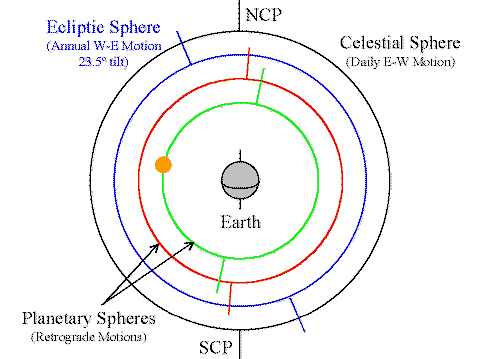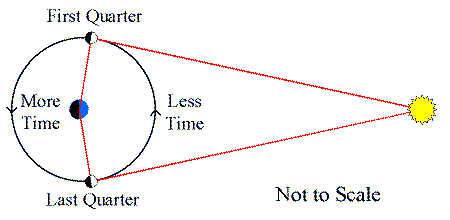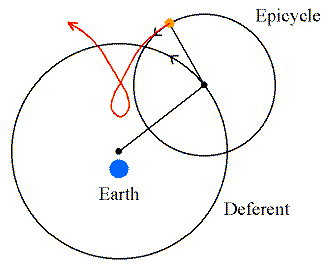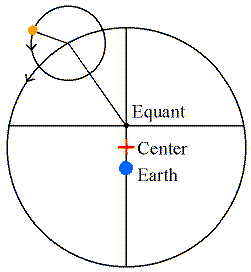Lecture 13: The Harmony of the Spheres:
Greek Astronomy
Key Ideas:
Early Geocentric Systems:
- Anaximander
- Pythagoras, Eudoxus, & Aristotle
Early Heliocentric System:
Epicyclic Geocentric Systems:
- Hipparchus of Nicaea
- Claudius Ptolemy
Summary of Celestial Motions
Fixed Stars:
- Uniform daily motion about the celestial poles.
The Sun:
- Daily motion around the celestial poles (rising and setting).
- Eastward drift along the Ecliptic over a year, a little
faster in winter, slower in summer.
The Moon:
- Daily motion around the celestial poles.
- Eastward motion near the Ecliptic over a month.
The Planets:
- Daily motions about the celestial poles.
- Generally eastward motion near the Ecliptic at different
speeds for each planet.
- Occasional westward "retrograde" motions.
- Superior Planets are brighter at opposition, fainter at
conjunction.
Any successful description of the Solar System must explain
all these facts.
The Geocentric System
Geocentric = Earth-Centered
Anaximander of Miletus (611-546 BC)
Among the first Greek philosophers to suggest a geocentric
system:
- Earth was a flat disk (cylinder) fixed and unmoving at
the center.
- Sun, Moon & Stars were affixed to rotating crystalline
spheres centered on the Earth.
- Sun, Moon & Stars were physical objects.
This was an interesting mix of old (flat earth) and new ideas that set
the basic themes for much of what was to follow.
Pythagoras of Samos (569-475 BC)
Philosopher & Mathematician, founded the Pythagorean school. Taught
that spheres are the perfect geometric shapes.
Pythagorean Model:
- Spherical Earth fixed at the center
- Planets & Stars on concentric crystalline spheres
- Sizes were ratios of small numbers (e.g., 2:1, 3:2)
Vibrations from their rubbing together created a harmonious
"Music of the Spheres.
Eudoxus of Cnidos (b. 408 BC)
A pupil of Plato, Eudoxus elaborated a geocentric model composed of
crystalline spheres, incorporating the Platonic ideal of uniform
circular motion.
System of 27 Spheres:
- 1 for the fixed stars
- 3 each for the Sun and Moon
- 4 each for the 5 planets
Spheres within spheres in perfect circular motion combine to
give retrograde motions.
Spheres within Spheres

(Click on the image to view at full scale [Size: 20Kb])
Four Spheres for each planet:
- One was aligned with the celestial poles, turning once a
day to give rising & setting.
- Second was tilted 23.5°, rotated slowly in the opposite
direction to give the usual west-to-east drift of the
planets relative to the fixed stars.
- Third & Fourth were introduced to produce the
periodic retrograde motions of the planets.
All were in uniform circular motion about their axes.
Aristotle (384-322 BC)
Another pupil of Plato, the tutor of Alexander the Great, and considered
the greatest general authority in antiquity. Aristotle wrote about
virtual everything known at his time.
His On the Heavens refined Eudoxus' system:
- 55 crystalline spheres within spheres
Incorporated physical reasoning:
- Earth fixed and unmoving at the center as it was too big
to move, including rotation.
- All spheres were in uniform circular motion.
- Combination of perfect motions produced net retrograde
and non-uniform motions.
Earth, Air, Fire, & Water
The Aristotelian World View made certain basic assumptions:
- The Earth was a sphere, fixed and unmoving at the center
of the Universe.
- The natural state of motion on the Earth was rest.
- The natural state of the Heavens was unceasing
uniform circular motion (or combinations of such motions).
A rotating or revolving Earth would thus be unnatural in this
world view.
Preserving Appearances
The models proposed sought primarily to "preserve
appearances":
- Started from philosophical ideals.
- Built systems to conform to these ideals.
- Adjusted to provide accurate predictions of planetary motions.
- No need to explain the physical "causes" of the motions.
The Aristotelian view of the world was that planetary motions belonged
to the perfect celestial realm, and were thus to be understood without
needing to inquire as to their physical "causes". In this sense,
Aristotle linked Astronomy with Mathematics, where one explored, say,
the geometric properties of triangles without any need to ask
why they were that way. Mathematics and Astronomy were seen as
expressions of perfection in and of themselves. This is unlike the
study of Physics, which to Aristotle was concerned with understanding
the causes of phenomena in the ever-changing realm of the Earth. This
conceptual separation of Astronomy from Physics was to have a profound
impact upon the Medieval and Renaissance mind centuries later.
The Heliocentric System:
Heliocentric = Sun-Centered
Alternative viewpoint to Geocentric:
- Puts the Sun, not the Earth, at the center.
- The Earth rotates and revolves around the Sun.
- Stars are on an outermost celestial sphere.
The complex non-uniform and retrograde motions are now just a
consequence of viewing moving planets from a moving Earth.
Aristarchus of Samos (310-230BC)
Proposed a Heliocentric system. It seems that his reasoning was the
large size he found for the sun.
- Showed geometrically that the Sun was at least
20x further than the Moon.
- Really 400x further: sound method, but inadequate data.
- Meant Sun was 5x bigger than the Earth (more like
109x, again, sound method but inadequate data).
- Makes it even more absurd that the Sun should move, if the Earth
was too large to move according to Aristotle.

(Click on the image to view at full scale [Size: 9Kb])
We know none of the details of Aristarchus' Heliocentric model. We only
have his treatise on the distances and sizes of the Moon and the Sun,
from which we gather what his motivations might have been. We know of
his Heliocentric model only from mention of it (usually dismissively) by
others who came after him. In particular, Archimedes discussion of it
in his Sand Reckoner is our best source.
The heliocentric idea never caught on, perhaps because it was considered
too radical given deeply ingrained notions about uniform circular motion
and the immobility of the Earth.
Hipparchus of Nicaea (165-127 BC)
Greatest astronomer of the classical period:
- Discovered the Precession of the Equinoxes
- Developed the system of stellar magnitudes
Developed a New and Improved Geocentric System:
- Introduced epicycles, building on ideas of Apollonius of
Perga.
- Located the Earth slightly off-center (eccentric)

(Click on the image to view at full scale [Size: 7Kb])
The main circle is the Deferent, upon which rotates the center of
the secondary circle called the Epicycle to which the planet is
affixed. The two rotate at different rates, fine-tuned to make the
apparent motions as seen from the Earth come out right. Additional
epicycles are added to further fine-tune the system. Notice that the
Earth is not exactly at the center, but slightly offset at the
"eccentric" point.
Successes of Epicycles & Eccentrics
Epicyclic models have a number of successes:
- Combined motion of deferent and epicycle produces retrograde motion.
- Superior planets are brighter at opposition, when moving retrograde.
- Placing the Earth at an eccentric away from the deferent center helps
explain the observed non-uniform motions of the Sun, Moon, and Planets.
- Can fine-tune the model by adding epicycles
Note:
What distinguishes Hipparchus' geocentric model from all previous models
is that it was firmly grounded in observational data, many observations
of which he made himself (by all accounts Hipparchus was the supreme
observational astronomer of the classical period). In many ways, this
work marks a turning point between models motivated primarily by
philosophical aesthetics and models based at least in part upon observational
data. Hipparchus still sought to preserve appearances, and chose a reasonable
(to him) geometric model to represent planetary motions mathematically.
Claudius Ptolemais (Ptolemy - c. 150 AD)
Astronomer and Geographer of the late classical age based at
Alexandria, then a colonial outpost of the Roman Empire.
Wrote the Mathematical Syntaxis:
- Compilation of all Mathematical & Astronomical knowledge of his time.
- Known to us in Arabic translations that hailed it
"Al Magest" ("The Greatest").
- Vastly influential work in medieval Europe after the 11th century.
Elaborated Hipparchus' geocentric system, adding extra features to
better preserve appearances.
The Equant
Ptolemy introduced the Equant, a geometric "device" to account
for observed changes in a planet's speed as it moved around the Earth.

(Click on the image to view at full scale [Size: 6Kb])
- The Epicycle still moves about the center of the Deferent, but
- Uniform circular motion about the center of the deferent
is replaced by uniform "angular" motion
about an off-center equant point.
This is a very complex construction that, again, was introduced to
preserve appearances, this time by replacing the pure Aristotelian and
Platonic ideal of Uniform Circular Motion with a slightly modified
notion of uniform angular motion about the equant.
The Ultimate Geocentric System
Ptolemy's final geocentric system was quite complex:
- 40 epicycles and deferents.
- Equants and eccentrics for all planets, the Moon, and Sun
- With only minor modifications, it provided accurate
predictions of the motions of the planets, Sun, and Moon.
It was to prevail virtually unchallenged for nearly 1500 years.
Return to [Unit 3 Index
|
Astronomy 161 Main Page]
Updated: 2005 October 7
Copyright © Richard W. Pogge,
All Rights Reserved.



